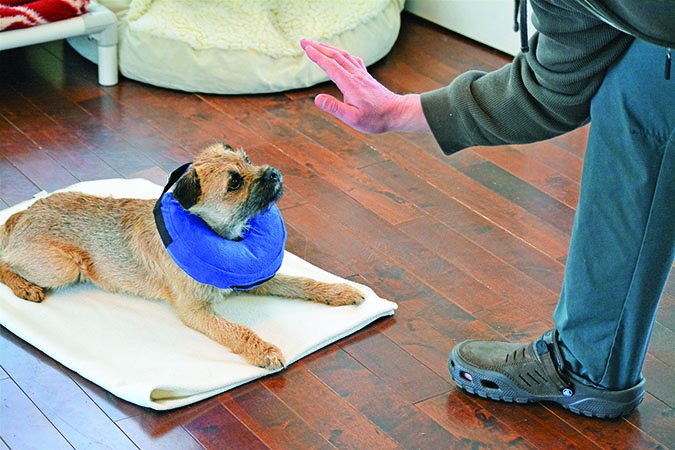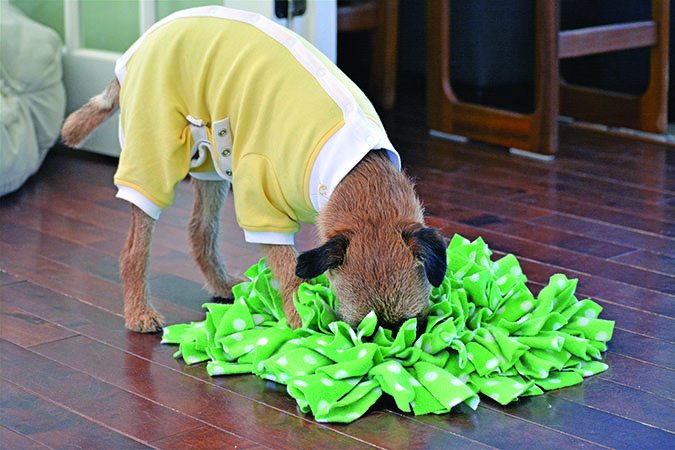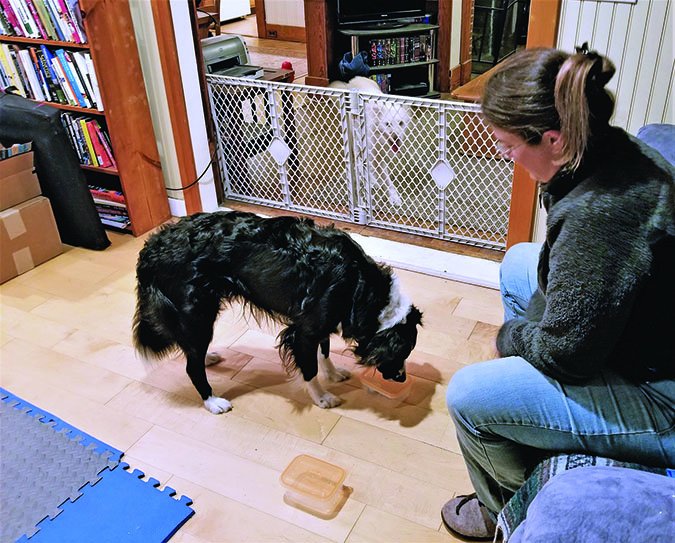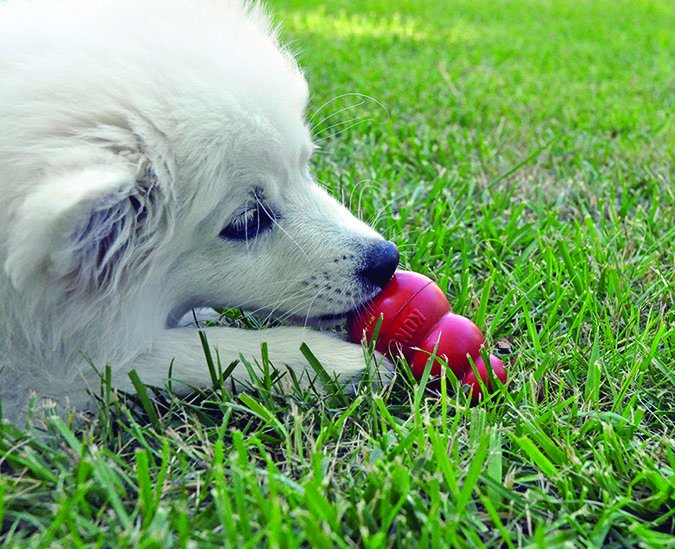We dog owners spend a lot of time coming up with ideas to keep our dogs exercised, entertained, and socialized. “Do more with your dog!” is a mantra that keeps us on our toes and looking for ways to ensure our pooches lead an active, fulfilled life.
Then one day, should our dog be injured or undergo surgery, we’re instructed by our vet to keep Fido quiet – maybe even immobile! – during a recovery period that can range anywhere from a few days to weeks or (gasp) months.
When our own doctor gives us strict orders to take it easy for two weeks while we recover from surgery or an injury, we understand that doing so is for our own good. We know that going against instructions can land us back in the doctor’s office with a secondary problem and can make our recovery time even longer. That’s often incentive enough to do what we’re told to stay out of trouble!

Our dogs, though, don’t follow the same rationale. When they start to feel better, they want to resume their daily activities immediately. They’re ready to jump and run and chase and play. It’s our responsibility to keep them quiet, and this can become an exercise in frustration for everyone involved.
How Do You Keep a Dog Calm?
So what can you do when your dog needs to chill against his will? These tips should help you get through your dog’s recovery time:
1. Your vet may prescribe a tranquilizer for your dog.
Seriously consider it. As someone who’s just recently gone through a week with a highly energetic post-surgical dog (we’re on Week Two as I type), I can vouch for the benefits of accepting that prescription with glee. I’m not talking about something that will knock your dog out cold, but something that can help take the edge off.
We were prescribed Trazodone, a tricyclic antidepressant that has the added effect of a mild sedative. Without it, Bennigan, my Border Terrier, would have felt ready to resume his twice-daily “zoomies” routine far too soon – up and down the stairs, on and off the couch, usually while barely touching the floor.
While medicated, Bennigan is able to walk around as normal. He’s not staggering or “out of it.” He’s just much more serene and will happily curl up and snooze for most of the day – which is exactly what the doctor ordered. When he’s awake, he is perfectly alert and enjoys playing brain games. His appetite for treats is alive and well, making training sessions more than possible.
As a bonus, his tranquil state makes it far easier for him to accept wearing his Kong Cloud “donut” (an alternative to the classic plastic Elizabethan collar or “cone of shame”). He’s also taken more easily to wearing his post-surgical onesie pajama, designed to prevent him from licking his wound or pulling at his stitches – activities he’s proven he can’t resist.
Bennigan is particularly sensitive to two things he finds very aversive: Confinement (like a crate) and having something on his body like a harness (which we’ve been working very hard to address, successfully!). The prescribed medication completely eliminated the need to physically confine him in a crate in order to control his movements (which would cause him undue stress), and it also erased any sensitivity to the onesie on his body. He wore it happily, which proved to be an immense help (in addition to being absurdly cute).

2. Use mentally tiring, low-key activities to wear him out.
We know that engaging your dog’s nose is an activity that doesn’t require much (if any) physical exertion. We also know that scent work can be immensely satisfying and tiring for your dog.
If your dog has permission from your vet to move around quietly, you can hide his food or some treats around an area in your home that’s safe for him to maneuver and encourage him to sniff out the goods. You can also hide some treats or kibble in a snuffle mat – an ideal solution for a dog who should move around as little as possible. With the snuffle mat, he can stay in one place while engaging his nose.
Weather permitting, you could sprinkle kibble in the grass in an enclosed area small enough to prevent your dog from running or jumping around. A temporary enclosure can be created with an exercise pen.
3. Low-activity training lessons.
There are still plenty of training activities you can engage in while keeping your dog relatively quiet. Naturally, all the high-energy sports are out of the question, but what about those that are low-key?
Jessica Hekman DVM, PhD, recently needed to adjust her dog’s training activities. Dash, an 18-month-old English Shepherd, is an active dog whose recurring issues with one of his shoulders has led Jessica to explore the possibility of orthopedic surgery. While they wait several weeks for their meeting with the orthopedic surgeon to discuss the next steps, Dash needs to stay quiet and can’t participate in his usual activities like agility practice.
But how do you minimize the physical activity of an athletic dog like Dash without driving him stir-crazy?
“Dash now does Rally with my husband at the same venue where we used to train in agility. We are also doing an online nose-work class through Fenzi Dog Sports Academy,” says Jessica.

Even though Dash can’t participate in high-impact sports, he and Jessica have managed to stay plenty busy by learning lots of tricks. They’ve even earned Dash his AKC Novice Trick Title while on “rest”!
“We practice our toy play, food play, and personal play. Coincidentally, we have some guest cats staying with us for a few months. Dash is overly excited by them, so they live in their own room. A couple of times a day, I let him interact with them and reward for calm behavior. This is great enrichment for him and hopefully will lead to more freedom for the cats. We’re making great progress!
“I’ve also taken him to pet supply stores or Home Depot/Lowe’s on leash and let him meet interested people. He gets a stuffed frozen Kong daily, but this was always the case. It’s just more important now.”
Check out how to teach your dog the names of objects here – it’s the perfect training game for when your dog has a lot of down time.
4. Play advanced brain games.
Some of the low-energy training exercises mentioned above are terrific ideas for the dog who’s at least able to move around, but what about the dog who should be as immobile as possible?
That’s when you and your dog both really need to use your brains. Object discrimination games – while lots of fun – can be very intellectually demanding for the dog. It’s a great way to challenge and tire out a stir-crazy dog who needs to be on complete rest.
With discrimination games, the idea is to teach your dog to differentiate between various objects. You can teach him the “name” of a few objects and ask him to target them with his paw or his snout, or to pick them up on cue. It’s a great way to teach your dog what his toys are called! This game can be played without your dog needing to move at all, so it’s perfect for the canine patient who’s supposed to be on strict rest.
Get more brain games to play with your dog here.
5. Practice impulse control exercises.
Take advantage of your dog’s needing to stay calm by practicing behaviors that require him to be immobile, like Stay, Wait, and Off (aka Leave It). It’s a perfect time to practice handy behaviors, all while continuing to rest!
6. Give your dog relaxing massages.

Learn canine massage techniques. I don’t know about you, but a good massage will put me in a zen state of mind that will last for several hours. Your dog can experience the same relaxing sensation with proper massage techniques.
Keep in mind the location of his injury – depending on the nature of it – you may want to either avoid it or target it! Choose a quiet spot in your home, play some relaxing music, and spend some one-on-one time massaging your dog. You’ll find it’s relaxing for both of you!
7. Keep the dog’s mouth busy.
If your dog can’t move his body, let him work on something with his mouth. A frozen Kong is an easy choice, since you can stuff it with low-calorie ingredients. You’ll want to watch your dog’s food intake while he’s less active. Putting on extra pounds can make recovery harder.
Prepare Your Dog Ahead of Time
Recovering from an injury or surgery isn’t an easy process, and it’s made more difficult by the fact that we can’t simply explain to our dogs why they need to lay low for a while. But with a little creativity and some planning, you’ll both get through it!
Even if your dog is currently in excellent health, take the time now to practice a few things that will come in handy later. Play games to help him make a positive association with a crate, an Elizabethan collar (the plastic cone or equivalent), a body wrap (like a onesie), or a sock on a limb.
Nancy Tucker, CPDT-KA, is a full-time trainer, behavior consultant, and seminar presenter in Quebec, Canada.






Thanks for the tip to play advanced brain games like teaching our dog to differentiate between a few various objects. My I need to find a good veterinary laser surgeon because my pet needs surgery soon, and I want to make sure I’m prepared to take care of him after the procedure. I’m glad I read your article because keeping your advice in mind should help my dog stay healthy and engaged even as he’s resting after the surgery.